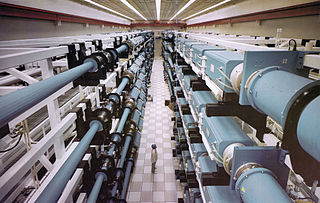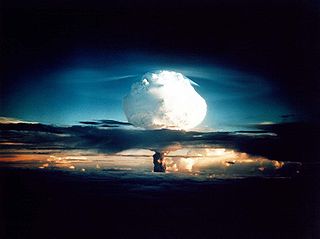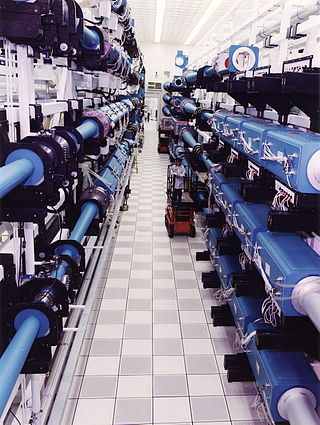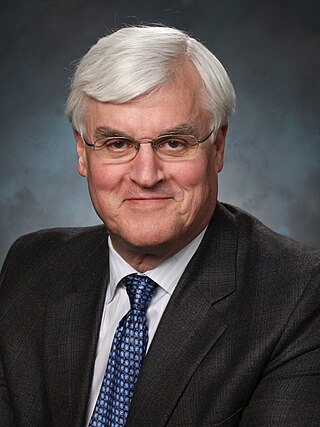Lawrence Livermore National Laboratory (LLNL) is a federally funded research and development center in Livermore, California, United States. Originally established in 1952, the laboratory now is sponsored by the United States Department of Energy and administered privately by Lawrence Livermore National Security, LLC.

Inertial confinement fusion (ICF) is a fusion energy process that initiates nuclear fusion reactions by compressing and heating targets filled with fuel. The targets are small pellets, typically containing deuterium (2H) and tritium (3H).
This timeline of nuclear fusion is an incomplete chronological summary of significant events in the study and use of nuclear fusion.

The National Ignition Facility (NIF) is a laser-based inertial confinement fusion (ICF) research device, located at Lawrence Livermore National Laboratory in Livermore, California, United States. NIF's mission is to achieve fusion ignition with high energy gain. It achieved the first instance of scientific breakeven controlled fusion in an experiment on December 5, 2022, with an energy gain factor of 1.5. It supports nuclear weapon maintenance and design by studying the behavior of matter under the conditions found within nuclear explosions.
The Laboratory for Laser Energetics (LLE) is a scientific research facility which is part of the University of Rochester's south campus, located in Brighton, New York. The lab was established in 1970 with operations jointly funded by the United States Department of Energy, the University of Rochester and the New York State government. The Laser Lab was commissioned to investigate high-energy physics involving the interaction of extremely intense laser radiation with matter. Scientific experiments at the facility emphasize inertial confinement, direct drive, laser-induced fusion, fundamental plasma physics and astrophysics using the Omega Laser Facility. In June 1995, OMEGA became the world's highest-energy ultraviolet laser. The lab shares its building with the Center for Optoelectronics and Imaging and the Center for Optics Manufacturing. The Robert L. Sproull Center for Ultra High Intensity Laser Research was opened in 2005 and houses the OMEGA EP laser, which was completed in May 2008.

A fusion energy gain factor, usually expressed with the symbol Q, is the ratio of fusion power produced in a nuclear fusion reactor to the power required to maintain the plasma in steady state. The condition of Q = 1, when the power being released by the fusion reactions is equal to the required heating power, is referred to as breakeven, or in some sources, scientific breakeven.

Nova was a high-power laser built at the Lawrence Livermore National Laboratory (LLNL) in California, United States, in 1984 which conducted advanced inertial confinement fusion (ICF) experiments until its dismantling in 1999. Nova was the first ICF experiment built with the intention of reaching "ignition", a chain reaction of nuclear fusion that releases a large amount of energy. Although Nova failed in this goal, the data it generated clearly defined the problem as being mostly a result of Rayleigh–Taylor instability, leading to the design of the National Ignition Facility, Nova's successor. Nova also generated considerable amounts of data on high-density matter physics, regardless of the lack of ignition, which is useful both in fusion power and nuclear weapons research.

Inertial Fusion Energy is a proposed approach to building a nuclear fusion power plant based on performing inertial confinement fusion at industrial scale. This approach to fusion power is still in a research phase. ICF first developed shortly after the development of the laser in 1960, but was a classified US research program during its earliest years. In 1972, John Nuckolls wrote a paper predicting that compressing a target could create conditions where fusion reactions are chained together, a process known as fusion ignition or a burning plasma. On August 8, 2021, the NIF at Livermore National Laboratory became the first ICF facility in the world to demonstrate this. This breakthrough drove the US Department of Energy to create an Inertial Fusion Energy program in 2022 with a budget of 3 million dollars in its first year.
The National Nuclear Security Administration (NNSA) is a United States federal agency responsible for safeguarding national security through the military application of nuclear science. NNSA maintains and enhances the safety, security, and effectiveness of the U.S. nuclear weapons stockpile; works to reduce the global danger from weapons of mass destruction; provides the United States Navy with safe and effective nuclear propulsion; and responds to nuclear and radiological emergencies in the United States and abroad.
Fusion ignition is the point at which a nuclear fusion reaction becomes self-sustaining. This occurs when the energy being given off by the reaction heats the fuel mass more rapidly than it cools. In other words, fusion ignition is the point at which the increasing self-heating of the nuclear fusion removes the need for external heating. This is quantified by the Lawson criterion. Ignition can also be defined by the fusion energy gain factor.

Penrose "Parney" C. Albright is an American physicist known for his work with the U.S. Government, think tanks and National Laboratories, and government contractors. Since November 1, 2014, he has been the president and CEO of HRL Laboratories, a research firm jointly owned by Boeing and General Motors. Until December 2013 he served as the director of Lawrence Livermore National Laboratory, and, in 2014, he served as a senior advisor in the Office of the Director of National Intelligence.
William W. Simmons is an American physicist at TRW and Lawrence Livermore National Laboratory (LLNL), notable for his development of electro-optical devices.

LIFE, short for Laser Inertial Fusion Energy, was a fusion energy effort run at Lawrence Livermore National Laboratory between 2008 and 2013. LIFE aimed to develop the technologies necessary to convert the laser-driven inertial confinement fusion concept being developed in the National Ignition Facility (NIF) into a practical commercial power plant, a concept known generally as inertial fusion energy (IFE). LIFE used the same basic concepts as NIF, but aimed to lower costs using mass-produced fuel elements, simplified maintenance, and diode lasers with higher electrical efficiency.
Félicie Albert is a French-born American physicist working on laser plasma accelerators. She is the deputy director for the Center for High Energy Density Science at Lawrence Livermore National Laboratory and staff scientist at the National Ignition Facility and Photon Science Directorate and the Joint High Energy Density Sciences organization. She received BS in 2003 in engineering from Ecole Nationale Supérieure de Physique de Marseille, in France, her master's degree in optics from the University of Central Florida in 2004 and her PhD from Ecole Polytechnique in 2007, before joining LLNL as a postdoctoral fellow in 2008. Her main expertise are "the generation and applications of novel sources of electrons, X-rays and gamma-rays through laser-plasma interaction, laser-wakefield acceleration and Compton scattering."
Dmitri Dmitriyevich Ryutov is a Russian theoretical plasma physicist.
John D. Lindl is an American physicist who specializes in inertial confinement fusion (ICF). He is currently the chief scientist of the National Ignition Facility at the Lawrence Livermore National Laboratory.
The history of nuclear fusion began early in the 20th century as an inquiry into how stars powered themselves and expanded to incorporate a broad inquiry into the nature of matter and energy, as potential applications expanded to include warfare, energy production and rocket propulsion.

Tammy Ma is an American plasma physicist who works on inertial confinement fusion at the Lawrence Livermore National Laboratory.

Andrea Lynn "Annie" Kritcher is an American nuclear engineer and physicist who works at the Lawrence Livermore National Laboratory. She was responsible for the development of Hybrid-E, a capsule that enables inertial confinement fusion. She was elected Fellow of the American Physical Society in 2022.

Maria Gatu Johnson is a Swedish-American plasma physicist whose research involves the use of neutron spectrometry to study inertial confinement fusion and stellar nucleosynthesis. She works at the Massachusetts Institute of Technology as a principal research scientist in the MIT Plasma Science and Fusion Center.










